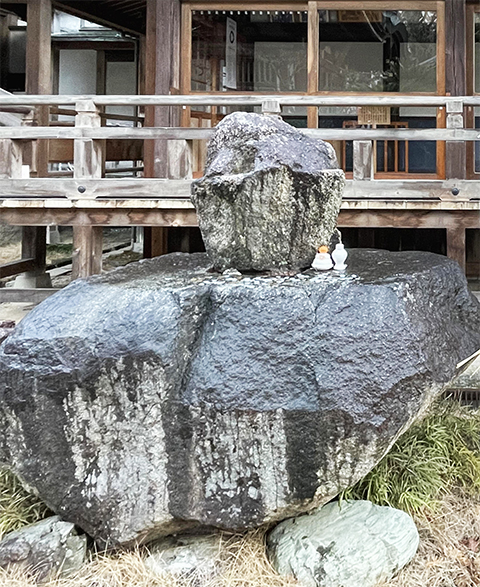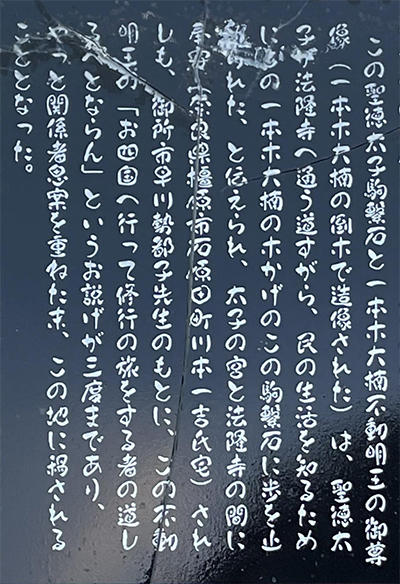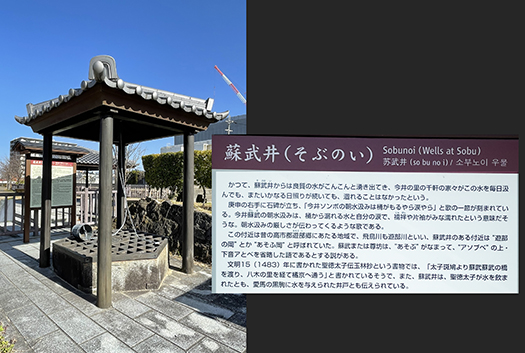


さて、なし崩し的に温泉山安楽寺探訪篇であります(笑)。特段、四国八十八箇所めぐりを志向しているのではないのですが、「面白そうなトコ」というカミさんの選択基準に合致しての宿泊。
到着したのは夕食時間も迫っていた時間だったので、宿坊側からも「いまはどのあたりにいらっしゃいますか?」という問合せが入ったりしていた💦。レンタカーで一路向かっていて地域幹線道路から寺院側に曲がった時点で、ジャストタイミング。でもほかの旅宿のみなさんはすでに夕食を待っていられた時間。ほうほうの体で夕食に。
で、そこから面白い「灌頂窟」という、まるで仏の体内ツアーのような秘所にもご案内いただいた。いろいろな寺院建築を見て来ているけれど、まことにえぐられる(!)思い。ぜひ、機会があればこちらに宿泊されることをオススメします。
で、ようやく疲れを癒した後、翌朝、寺院内を歩かせていただいた。そこで目が点になったのが、こちらの聖徳太子「駒つなぎ石」。え、なんでこの四国に聖徳太子ゆかりのものが???、と。そこで置かれていた「説明板」のその説明箇所をアップしました。
要約すると聖徳太子がご自分の「宮」から斑鳩の法隆寺の間を往還する際に馬に水やりするとき、休息がてら民の暮らしぶりに目をかけられていたというのですね。その馬をつないでいた石を所有されていた奈良県御所市に在住する「早川勢都子」先生(宗教者とのこと)の枕元に、化身となった不動明王が三度も立って「四国に行って修行の旅をする者の道しるべとならん」というお告げがあったという。
そこで関係者が協議した末に、この四国八十八箇所第六番札所に遷座したのだという。参考までに以下の文献の関係部分を転載。
〜駒繋石・不動尊の由来(三山堂文書より)
大和三山は古来日本歴史を学ぶ者の熟知する所でその一つである耳成山には第三十三代女帝推古天皇の耳梨(耳成)行宮がありました。摂政宮であらせられた聡明叡知神徳高き、聖徳太子はこの行宮(仮宮)に行啓になり、又斑鳩宮(法隆寺)へ御通ひの道すがらこの地石原田古墓塚の一本楠の神木の下で御休憩あそばされました。この巨石は駒つなぎの石と申し、太子の御乗馬をつながれたものと伝えられています。〜

で、この四国行きのずっと前に奈良県橿原市今井町の周辺を流れる「飛鳥川」の河辺で「聖徳太子が馬に水を飲ませた井戸」があって、その写真を収めていたことが思い出された。
事実関係について詳細に調査するというような意思はありませんが、どうもわたし自身の紀行体験との符合があって、玄妙な気分にさせられております。たまたま訪れていた橿原の河辺と、カミさんがたまたま差配した四国の旅宿の宿坊が運命の糸で決定(けつじょう)してしまったワケです。
まぁ年齢相応には仏心はありますが、・・・どういう因果なのかと。
English version⬇
Shotoku Taishi “Koma Tsunagi Ishi” in Onsensan Anrakuji Temple, Shikoku, Japan
A strange encounter of chance. A strange encounter with a giant’s trail of Shotoku Taishi – Kobo Daishi Kukai. …
Now, without much ado, here is a visit to Onsan Anraku-ji Temple (laugh). We were not particularly interested in visiting the 88 temples of Shikoku, but we stayed at an inn that met my wife’s selection criteria of “an interesting place.
When we arrived at the inn, it was almost dinner time, so the innkeeper asked us, “Where are you now? 💦. We were on our way by rental car, and just in time to turn off the regional highway onto the temple side. But everyone else in the hotel was already waiting for dinner. So we went to dinner with a sigh of relief.
We were taken to the interesting “Perfumed Cave,” a secret place that was like a tour inside the body of a Buddha. I have seen many kinds of temple architecture, but this was truly a gut-wrenching (!) experience. I have seen many temples, but this one is truly gut-wrenching (!). I highly recommend staying here if you have the chance.
The next morning, after finally recovering from my fatigue, I was allowed to walk around the temple. There, my eyes were drawn to this Prince Shotoku “Koma Tsunagi” stone. What? Why is there something related to Prince Shotoku here in Shikoku? I thought. I uploaded the explanation on the explanation board.
In summary, when Prince Shotoku Taishi watered his horses on his way back and forth between his palace and Horyuji Temple in Ikaruga, he took a rest and paid attention to the people’s lifestyle. The stone that connected the horse to the “Fudo Myoo,” which had become an incarnation of Fudo Myoo three times, stood at the bedside of Dr. Seitoko Hayakawa (a religious person), who resided in Gosho City, Nara Prefecture, and told her that he would be a guide for those who travel to Shikoku to practice asceticism.
After discussions among the people concerned, he was relocated to the sixth of the 88 temples of Shikoku. For reference, the following documents are reproduced in their relevant parts.
〜Origin of the Koma-tsunagiishi and Fudo-son (from Sanzando documents)
The three mountains of Yamato are well known to students of Japanese history since ancient times, and one of them, Mount Miminari, was home to the Miminashi (Miminari) Palace of the 33rd Empress Suiko. The regent Prince Shotoku Taishi, a man of great wisdom, wisdom, and virtue, visited this temporary palace and rested under the sacred camphor tree at the Ishiwarada ancient tomb mound on his way to Ikaruga Palace (Horyu-ji Temple). This boulder is said to be the “Koma-tsunagi no Ishi,” the stone on which the Prince’s horse was hitched. 〜From the top of this page
I was reminded that before my trip to Shikoku, I had taken a picture of a well where Prince Shotoku gave water to his horses on the banks of the Asuka River, which flows around Imai-cho, Kashihara City, Nara Prefecture.
Although I have no intention of conducting a detailed investigation of the facts, I am struck by the coincidence with my own travel experiences, and I am in a mysterious mood. I happened to be visiting Kashihara’s Kawabe, and my wife arranged for me to stay at a lodge in Shikoku, and fate had a thread of luck in deciding which one to visit.
Well, I have a Buddha’s heart appropriate to my age, but…what kind of cause and effect is this?
Posted on 3月 2nd, 2024 by 三木 奎吾
Filed under: 日本社会・文化研究







コメントを投稿
「※誹謗中傷や、悪意のある書き込み、営利目的などのコメントを防ぐために、投稿された全てのコメントは一時的に保留されますのでご了承ください。」
You must be logged in to post a comment.